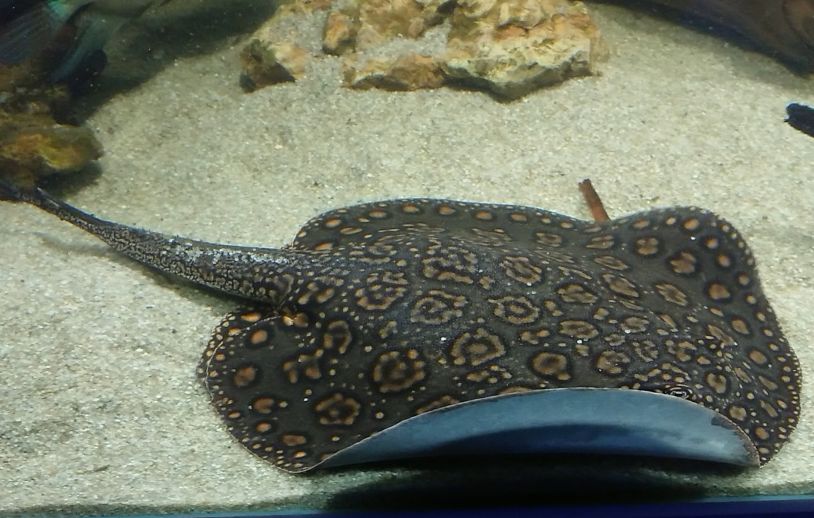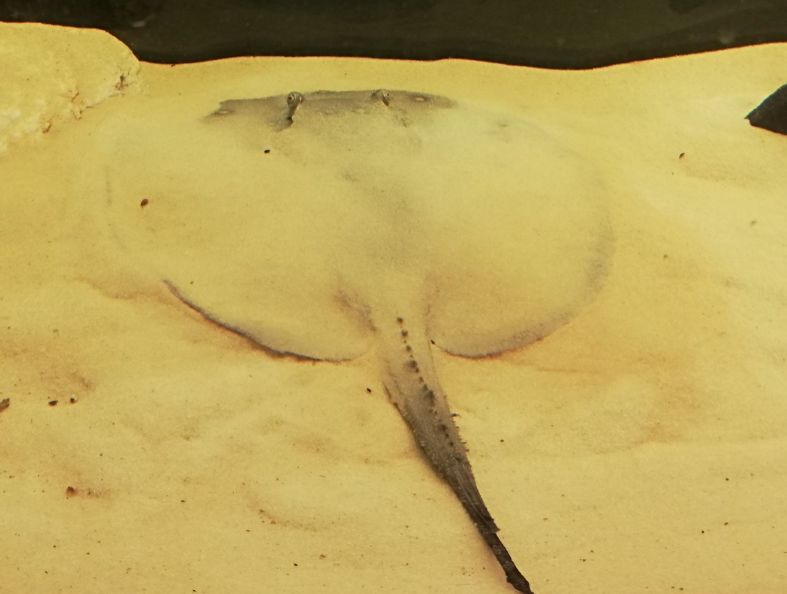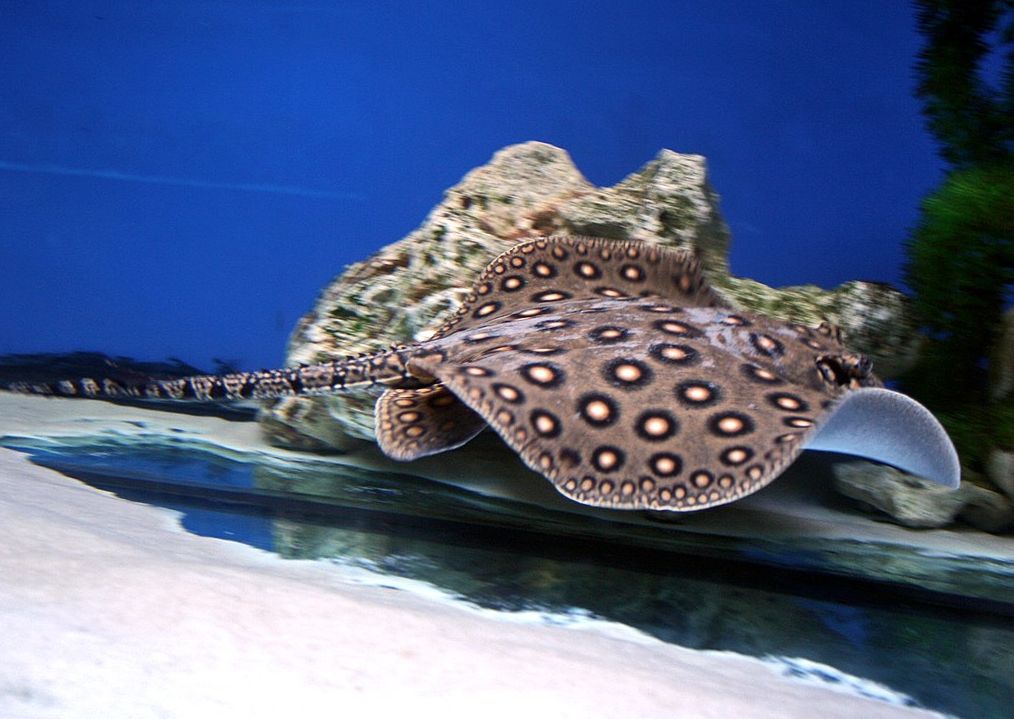The motoro stingray is one of the most popular freshwater stingrays in the aquarium hobby. Despite its widespread appeal, the classification of this species remains somewhat ambiguous. New varieties continue to be discovered and described, highlighting the ongoing exploration of this fascinating family of fish. Understanding these classifications is essential for enthusiasts who wish to provide the best care for their motoro stingray and appreciate its unique traits.

Contents
Habitat in the wild
The motoro stingray is a species of freshwater stingray belonging to the Potamotrygonidae family, commonly referred to as river stingrays or Neotropical freshwater stingrays. This group of cartilaginous fish is primarily found in South America, thriving in various freshwater habitats such as rivers, streams, and flooded areas.
Motoro stingrays have distinct physical features: a flattened body, wide pectoral fins resembling wings, and a long tail equipped with one or more venomous spines for defense. As primarily bottom-dwelling carnivores, they feed on small aquatic animals, including crustaceans, insects, mollusks, and small fish.
This species is widespread across South America, inhabiting regions in Colombia, Peru, Bolivia, Brazil, Paraguay, and Argentina. It is commonly found in the Amazon River and its tributaries, including the Orinoco, Rio Branco, Paraná, and Paraguay rivers.
Motoro stingrays occupy diverse biotopes, mainly sandbanks in large rivers and their tributaries, where the substrate consists of mud and sand. During the rainy season, these stingrays migrate to flooded forests, while in the dry season, they seek out lakes formed earlier in the year.
| Characteristic | Description |
|---|---|
| Scientific Name | Potamotrygon motoro |
| Family | Potamotrygonidae |
| Common Name | Motoro stingray; ocellate river stingray |
| Habitat | Freshwater rivers, streams, and flooded areas |
| Geographic Range | South America (Amazon River basin and surrounding areas) |
| Body Shape | Flattened and disc-like |
| Size | Up to about 16 inches (40 cm) in diameter |
| Coloration | Usually brown or gray with distinctive markings |
| Pectoral Fins | Large, wing-like fins used for swimming and gliding |
| Tail | Long, slender, and equipped with venomous spines |
| Diet | Carnivorous; feeds on small aquatic animals |
| Venomous Spines | Yes; used for defense |
| Behavior | Generally peaceful, but may become aggressive if threatened |
| Aquarium Requirements | Large tank with sandy substrate, strong filtration, and hiding spots |
| Water Parameters | Tropical freshwater; temperature around 75-82°F (24-28°C) and neutral to slightly acidic pH |
| Tank Size | Minimum 125 gallons (473 liters) for a single stingray |
| Compatibility | Generally should be kept with peaceful tank mates |
| Handling | Requires careful handling due to venomous spines |
| Conservation Status | Not Evaluated (IUCN Red List) |
Description
Rays are closely related to sharks and sawfishes, sharing a unique skeletal structure that sets them apart from typical bony fish. Unlike ordinary fish, rays possess a skeleton made entirely of cartilage, which contributes to their flexibility and adaptability in various aquatic environments. This cartilaginous framework plays a crucial role in their buoyancy and maneuverability, allowing them to thrive in diverse habitats.
Poisonous spine
The scientific name for the motoro stingray is the ocellate river stingray, a reference to its ability to sting. This species has a venomous spine on its tail, which is actually a modified scale. The spine serves as a defensive mechanism; when threatened, the stingray can arch its tail to deliver venom to potential predators. The poison, produced by glands near the base of the spine, can cause intense pain, swelling, and in severe cases, may even be harmful or fatal to humans.
Contrary to popular belief, rays do not actively attack humans. Stings typically occur when someone accidentally steps on or disturbs the ray. Interestingly, motoro stingrays lose their spines every 6 to 12 months, a natural occurrence that shouldn’t be a cause for concern. You may find these spines on the bottom of the tank.
It’s vital to handle motoro stingrays with extreme care and avoid touching their tails to prevent accidental stings. When encountering stingrays in the wild or while diving, it’s best to observe them from a safe distance and avoid any actions that might provoke them.
For those keeping motoro stingrays or other species in aquariums, understanding their behavior is crucial. Take necessary precautions to avoid accidental stings by using appropriate tools and techniques during maintenance. This ensures the safety of both the stingray and the aquarist.
Ampullae of Lorenzini
Another fascinating feature of freshwater stingrays is the ampullae of Lorenzini, specialized channels located around their eyes and nostrils. These structures allow cartilaginous fish to detect electric fields in the water, enabling them to navigate effectively using the Earth’s magnetic field. This sensory adaptation is crucial for their survival, helping them locate prey and avoid predators in their often murky aquatic environments.
Size
Motoro stingrays are relatively small compared to some other stingray species. In the wild, they can reach a diameter of up to 50 cm and a total length of about 1 meter, weighing as much as 35 kilos. However, when kept in an aquarium, motoro stingrays typically grow to a maximum size of around 30 to 35 centimeters (12 to 14 inches) in disc width, which measures the distance across the body from one pectoral fin to the other. Including the tail, their total length can extend to approximately 60 centimeters (2 feet) or slightly more.
Lifespan
In captivity, motoro stingrays typically live between 8 and 15 years, although some individuals can exceed this range with exceptional care and optimal conditions. Understanding the lifespan of motoro stingrays is crucial for potential aquarists, as it highlights the commitment required to provide a healthy and supportive environment throughout their lives. Factors such as water quality, diet, and tank size play significant roles in achieving longevity for these fascinating creatures.
Body
The motoro ray has a distinctive disk shape, nearly round in appearance, with its eyes positioned prominently on its back. Typically, its coloration ranges from beige to brown, adorned with numerous marigold yellow spots and dark circles. These striking patterns not only contribute to its beauty but also play a role in camouflage within its natural habitat, helping it blend into the riverbeds where it resides.
Color
The abdomen of the motoro ray is a striking white, contrasting with the colorful patterns on its back. The color and placement of the spots can vary significantly among individuals. In the Amazon river basin, researchers have identified three primary color types of stingrays, each encompassing several subtypes. This diversity not only adds to the species’ allure but also presents interesting challenges and opportunities for aquarists and breeders alike.

Difficulties in keeping
Keeping motoro stingrays as pets requires significant knowledge, effort, and dedication. These unique creatures have specific care needs, including a large, well-maintained aquarium with appropriate filtration and water conditions. Additionally, their venomous spines necessitate careful handling to prevent injury to both the stingray and the keeper. It’s essential to research thoroughly and seek guidance from experienced aquarists before considering keeping a stingray.
Among aquarists, the ocellate river stingray is one of the most popular species. Many are surprised to learn that some rays thrive in freshwater environments. Freshwater rays are quite intelligent and can interact with humans; in fact, they can even be trained to hand-feed. However, the motoro stingray is not suitable for everyone. It requires ample tank space, optimal conditions, and a specialized diet.
For those willing to invest the necessary effort, the motoro stingray can become a beloved and unique pet. Historically, many rays sold in the aquarium trade were caught in the wild, leading to stress and the potential for parasites and illnesses. Fortunately, most rays available today are bred in captivity, which typically results in healthier specimens.
Despite their appeal, motoro stingrays can pose dangers. In countries where these rays are found, they are often feared more than other dangerous species, such as piranhas. For instance, in Colombia, there are over 2,000 reported cases of injuries and even accidental deaths due to stingray encounters each year.
The venomous spine is located on the top of the ray’s tail and is protected by a thin outer layer. The internal surface of the spine features a row of reversed barbs, designed to tear through tissue and complicate removal from wounds. While the toxic properties of stingray venom can vary, they generally consist of proteins and chemicals that induce severe pain and tissue necrosis.
If stung by a motoro ray, be prepared for intense pain at the site of the sting, along with symptoms such as headache, nausea, and diarrhea. It is important to seek medical attention regardless of symptom severity.
While caution is crucial when keeping rays, the risk of being stung is low if treated with respect. Generally, these fish are not aggressive and only use their spines as a defense mechanism. Many rays become quite sociable, learning to recognize their owners and coming to the water’s surface to request food. Most injuries occur when careless owners attempt to pet the motoro ray or catch it with a scoop net.
Instead of using a net, opt for a solid container to ensure safe handling. This approach minimizes stress for both the stingray and the keeper, promoting a healthier and more enjoyable relationship.

Keeping in a tank
Water parameters
Freshwater rays are highly sensitive to ammonia, nitrites, and nitrates in their environment, making it crucial to understand the nitrogen cycle and maintain crystal-clear water in the tank.
Achieving this can be challenging, as rays produce significant amounts of ammonia. To create a healthy habitat, it is essential to use large tanks, implement efficient biological filtration, and perform regular water changes.
Most freshwater rays thrive in water with a pH range of 6.8 to 7.6, alkalinity between 1° and 4° (18 to 70 ppm), and a temperature of 24 to 26°C. It is vital to keep ammonia and nitrite levels at zero, while nitrates should remain below 10 ppm to ensure optimal health for the rays.
Tank size
Motoro stingrays require a spacious and well-sized aquarium due to their active nature and potential growth. These rays can reach a disc width of 18 to 24 inches (45 to 60 cm) and have long tails, so providing ample space to swim and move comfortably is essential.
When it comes to tank size, the general guideline is that larger is better. While height isn’t a critical factor, the tank should measure between 180 and 220 cm in length and 60 to 90 cm in width to accommodate a motoro ray over the long term.
A minimum tank size of around 180 to 250 gallons (680 to 950 liters) is often recommended for a single motoro stingray. However, for long-term care of adult specimens, a tank of at least 1,000 liters is necessary.
If you plan to keep multiple motoro stingrays or other fish in the same tank, you will need an even larger setup. As a rule of thumb, add at least 75 to 100 gallons (280 to 380 liters) for each additional stingray to meet their territorial and swimming requirements.
Substrate
Choosing the right substrate for a motoro stingray aquarium is essential for mimicking their natural habitat and promoting their well-being. As bottom-dwelling fish, stingrays rely on their substrate to create a comfortable and safe environment.
Fine sand is the ideal substrate for a motoro stingray tank. It allows the rays to partially bury themselves, a natural behavior that helps them feel secure and provides a space to hide and rest. The sand should be soft and free of sharp or abrasive particles to protect the delicate underside of the stingray.
Avoid using gravel or large pebbles, as these can be uncomfortable for the rays to navigate and may pose a risk of injury. Larger substrate materials can also trap debris, making it difficult to maintain a clean aquarium.
Before adding sand to the tank, it’s crucial to rinse it thoroughly to remove dust and impurities. A layer of 2 to 3 inches (5 to 7.5 centimeters) of sand is typically sufficient for a motoro stingray aquarium.
While some may consider keeping the tank substrate-free for easier maintenance, this option can make the environment appear stark and unnatural. Since stingrays enjoy digging into the sand when stressed, providing a substrate aligns with their natural behaviors. In the wild, they inhabit sandy or muddy bottoms, so denying them this opportunity can be detrimental to their well-being.
Decor
When decorating a tank for motoro stingrays, it’s important to choose smooth items without sharp edges to ensure their safety. While decorations aren’t strictly necessary, adding some large driftwood or smooth stones can enhance the tank’s aesthetic and provide hiding spots.
To create an optimal environment, it’s essential to leave plenty of open space for the stingrays to swim freely and dig into the sand. Any heaters should be protected or positioned outside the tank to prevent the rays from getting burned.
Lighting plays a significant role in the tank’s setup. A dim light with a 12-hour day/night cycle is ideal. While motoro stingrays may nibble on rooted plants, you can experiment with plants that can be secured to decorations, such as java moss or Anubias. However, keep in mind that even these hardy plants may struggle to survive the stingrays’ curiosity.
Diet
Motoro stingrays are carnivorous and primarily feed on fish and crustaceans in their natural habitat. Due to their active lifestyles and high metabolism, it’s essential to feed them at least twice a day. They are known for their hearty appetites, which can make feeding quite costly.
A varied diet is crucial for keeping motoro stingrays in optimal health. Young stingrays typically enjoy live or frozen foods like bloodworms, tubifex, brine shrimp, and prawns. As they mature, they require larger food items, such as whole mussels, shellfish, larger prawns, squid, and juvenile fish. Offering a diverse diet helps ensure their well-being.
After acquiring a motoro stingray, you might notice that it eats reluctantly at first, particularly if it’s not in the best condition. To encourage feeding, bloodworms and small pieces of earthworms are excellent options to help the stingray adapt to its new environment.
It’s crucial to avoid feeding motoro stingrays mammalian flesh, such as ox heart or chicken. They struggle to digest the lipids found in these meats, which can lead to serious health issues, including organ necrosis.
Additionally, feeding them with common aquarium fish like livebearers or small goldfish is not advisable, as this may increase the risk of introducing diseases and parasites into the tank.

Tank mates
Motoro stingrays spend most of their time on the bottom of the aquarium, with their eyes and gill openings positioned on top of their bodies. This unique adaptation allows them to remain partially buried in sand while waiting for prey. They possess excellent eyesight and can swiftly leap from the sand to catch their food.
When selecting tank mates for motoro stingrays, other types of rays make the best companions. However, certain larger species, such as Cichlasoma severum, Geophagus, silver arowana, and Polypterus, can also coexist peacefully with them.
In the wild, rays are significant predators, so it’s important to choose tank mates carefully. Compatible fish should be large enough to avoid becoming a meal but also peaceful enough to coexist without aggression or food competition.
Ideally, tank mates should inhabit the upper and middle water layers to minimize interaction with the motoro stingray. It’s advisable to avoid armored catfish as tank mates, as they have been known to get stuck to the rays, potentially causing skin damage.

Gender differences: male vs female
Female motoro stingrays are generally larger than males and possess two uteruses, allowing them to potentially carry offspring from two different males at the same time. Males have specialized fins, known as claspers, which they use for fertilization during mating. This unique reproductive strategy contributes to the diversity and adaptability of their populations in the wild.
Breeding
Breeding motoro stingrays can be a rewarding yet challenging endeavor that requires significant dedication and a suitable environment. They reproduce through ovoviviparity, with females carrying anywhere from 3 to 21 pups, which are born fully formed and ready to thrive independently. The gestation period typically lasts between 9 to 12 weeks, and interestingly, this duration may be shorter in captivity, likely due to better food availability compared to their wild counterparts.
It’s essential to note that motoro stingrays can be selective when it comes to choosing mates. Simply placing a male and female together in a tank does not guarantee successful breeding. A more effective approach involves acquiring a group of juveniles and allowing them to pair off in a spacious tank, although this can be a costly and time-consuming process, as it may take years for them to reach maturity.
During the spawning period, males can become quite aggressive, which may pose a challenge if the females are not ready. Close monitoring of their behavior is crucial, and be prepared to separate them if necessary to prevent stress or injury. Successful breeding requires not only the right conditions but also a keen understanding of their behaviors and needs during this critical time.